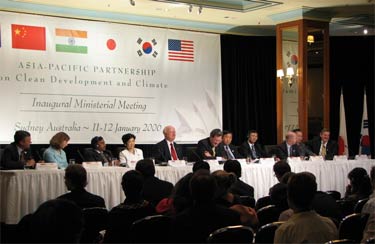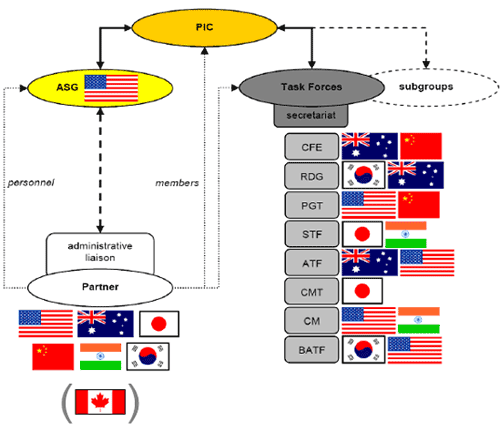 |
Christoph Holtwisch analyses the current development of the Asia-Pacific Partnership on Clean Development and Climate, contrasting the Partnership with the traditional climate regime. |
| The author is Erster Beigeordneter (deputy mayor) and division director of the municipality of Vreden and a lecturer for the Fraunhofer Institute UMSICHT in cooperation with the University of Hagen (all Germany). His legal PhD is on the non-compliance procedure of the Kyoto Protocol (2006) and his environmental sciences master thesis is on the Asia-Pacific Partnership on Clean Development and Climate (2007). | |
The Asia-Pacific Partnership on Clean Development and Climate is a relatively new phenomenon in international climate policy. In its own view, the Partnership is a grouping of key nations to address serious and long term challenges, including anthropogenic climate change. The Partnership founding partners of Australia, China, India, Japan, South Korea and the United States and their new partner Canada represent more than half the world's economy and population, energy consumption and global greenhouse gas emissions. For that reason, this "coalition of the emitting" is an essential factor in international climate policy.
Development and enlargement
After secret negotiations, the Asia-Pacific Partnership on Clean Development and Climate was announced on July 28th 2005 at an ASEAN regional forum in Vientiane, Laos, at which time a Vision Statement was released. The official creation of the Partnership was at an inaugural ministerial meeting on January 12th 2006 in Sydney, Australia. Here, the Asia-Pacific Partnership on Clean Development and Climate Charter was launched, accompanied by a Communiqué and a Work Plan. The Vision Statement is now an integral part of the Charter.
The second meeting of the Policy and Implementation Committee of the Partnership took place April 18th-21st 2006 in Berkeley, California, in the United States. This second meeting produced Guidelines for the Task Forces of the Partnership and for their Action Plans. At the third Policy and Implementation Committee meeting, held in Jeju, Korea, October 11-13th 2006, additional Guidelines for flagship projects were made. The Action Plans developed by the Task Forces were also accepted at this time by the Policy and Implementation Committee. On April 4th 2007, further Guidance to the Task Forces and a Procedure for Adding New Projects to the Partnership were published.
The fourth Policy and Implementation Committee meeting took place in Tokyo, Japan, July 19-20th 2007. It produced the Forms for Project Registration and status report already foreseen in the Procedure and the Guidance. The fourth Policy and Implementation Committee meeting also prepared for the second ministerial meeting of the Partnership, which took place on October 15th 2007 in New Delhi, India. At the New Delhi meeting, the ministers released a second Communiqué. This was accompanied by a flagship projects Brochure (18Mb download) and the launch of an Asia-Pacific Energy Technology Cooperation Centre. The enlargement of the Asia-Pacific Partnership on Clean Development and climate with the addition of Canada was also announced at that event. The ministers decided to meet again in 2009, with the Policy and Implementation Committee continuing with its work in the meantime.
The Asia-Pacific Partnership aims to continue with its efforts in technology cooperation and transfer whilst also locating additional financial resources for its projects. The partnership is open to enlargement by further interested countries in the future.
Character, aims and potential
The Asia-Pacific Partnership on Clean Development and Climate forms a non-legally binding political soft law regime. This is stated expressly and indicated by terms like "compact" (instead of treaty), "partners" (rather than parties) and "nations" (instead of states). Participation in the Partnership is, therefore, on a totally voluntary basis which makes the existing termination clause meaningless. Nevertheless, the Partnership should not be underestimated. The political binding is decisive even in international law that does not contain effective enforcement. While the Vision Statement uses the misleading expression "non-binding", the Charter prefers the term "non-legally binding" which indicates clearly that the Partnership is meant to be politically binding. Irritatingly, despite its true nature, the Charter tries to look like an international law treaty, which is one reason why it is overestimated by some observers.
 |
Asia-Pacific Partnership Inaugural Ministerial Meeting, Sydney, Australia, January 12th 2006 |
The Asia-Pacific Partnership on Clean Development and Climate follows the ideal of sustainable development with interlinked environmental, economical and social sub-aims. It contains the first connection of climate protection and energy security in an international agreement. To view climate policy as a sub-chapter of geopolitics may make it easier for the United States to be actively engaged in it. Partnership members recognize that renewable energy and nuclear power will represent an increasing share of global energy supply but stress that fossil fuels underpin their economies now and for the predictable future. The continued economic use of (cleaner) fossil fuels is consequently at the core of the Partnership policy. Critics, therefore, view it as a coal pact only. This is too simplistic but, without doubt, the technology of carbon capture and storage is one of the central technological options for the Partnership.
Instead of reducing absolute greenhouse gas emissions, the Asia-Pacific Partnership on Clean Development and Climate wants only to limit the greenhouse gas intensities of economic activities which would lead only to relative emission reductions (compared to a reference case). This plan presents an important difference from the cap and trade architecture of the Kyoto Protocol to the United Nations Framework Convention on Climate Change, and is much less ambitious than it. Even in the best case scenario - a global use of the Partnership approach with carbon capture and storage - absolute greenhouse gas emissions would more or less double from now to 2050. Therefore, the Partnership ideas are clearly not enough to respond sufficiently to climate change. Nonetheless, they may play some role in dealing with this challenge. Precise projections are impossible at this time and depend very much on future implementation of the Partnership.
Purposes, financing and implementation
The Asia-Pacific Partnership on Clean Development and Climate is meant to serve as a framework for international cooperation between its partners and for the coordination of their national strategies (within the use of capacity-building). At its core, the Partnership is an agreement for the development and transfer of environmentally-sound technologies. Economic freedom (with its legal and political aspects) is important for this as an enabling environment, so the Partnership contains an institutional dimension as well.
The technology cooperation builds on a great number of existing bi- and multilateral political initiatives such as the Methane to Markets Partnership or the Carbon Sequestration Leadership Forum, which are, like the Asia-Pacific Partnership on Clean Development and Climate, parallel tracks to the traditional United Nations climate regime. As the Partnership is not limited in terms of particular technologies, it has the potential to build up as a future framework for these initiatives.
Having in mind the different national laws regarding intellectual property of technologies, all these matters are to be addressed case-by-case. Generally, the financing of the technology development and transfer will be the crucial point for the Partnership. The financial contributions expected of the Partnership members are very limited and vague. For that reason, the inclusion of the private sector is fundamental for Partnership activities. As one spokesman said: "The real dollars we are looking for are the private sector dollars, we are talking tens of billions of dollars if not hundreds of billions of dollars. If we don't get the investment sector we can't succeed."
At this time, it does not look as though there will be enough financial support for the Partnership to be particularly successful, even though most of the presentations at the second and fourth Policy and Implementation Committee meetings dealt with the crucial topic of financing.
 |
| Institutions of the
Asia-Pacific Partnership PIC: Policy and Implementation Committee. ASG: Administrative Support Group. See text below for key to Task Forces |
The first Work Plan of the Partnership focuses on power generation and distribution, as well as key industries. Eight temporal public-private task forces have been established in addition to the permanent political Policy and Implementation Committee and its Administrative Support Group.
The eight task forces cover:
- cleaner fossil energy (CFE);
- renewable energy and distributed generation (RDG);
- power generation and transmission (PGT);
- steel (STF);
- aluminium (ATF);
- cement (CMT);
- coal mining (CM); and,
- buildings and appliances (BATF).
The Action Plans developed by the Task Forces and the different specific projects contained in it were accepted by the Policy and Implementation Committee at its third meeting in October 2006. The Committee endorsed a small number of new projects in 2007.
Relationship with the United Nations climate regime
The Asia-Pacific Partnership on Clean Development and Climate has important effects on the traditional United Nations Framework Convention on Climate Change (UNFCCC) regime. Officially, the Partnership is meant to be consistent with the principles of the UNFCCC and is intended to complement, but not replace, the Kyoto Protocol. The Partnership is, indeed, consistent with UNFCCC principles, but its position regarding the Kyoto Protocol is dubious. If it were to act as a complement, the Partnership must, like the Kyoto Protocol, go beyond what is embodied already in the UNFCCC. This is not the case. The Partnership is only one of the technological "partnerships" embodied in the UNFCCC technology framework.
So what are the exact intents of the Asia-Pacific Partnership on Clean Development and Climate? Does the Partnership want to complement the Kyoto Protocol or is it intended to replace the Kyoto Protocol? Some statements made by its representatives and also the timing of its meetings - usually just a few months before the UNFCCC/Kyoto Protocol meetings - indicate that it appears to want to replace the Kyoto Protocol.
The setting up of the Partnership as a competitive regime to the Kyoto Protocol is what is likely to have been intended because the Kyoto Protocol contains legally-binding emission commitments, which most of the Partnership members did not favour. Australia recently changed its position on this issue, as indicated by the ratification of the Kyoto Protocol by its new government. Overall then, it would appear that the Asia-Pacific Partnership on Clean Development and Climate is primarily intended to be an opposing model against the central ideas of the Kyoto Protocol and, at this time, it would seem it intends to replace the Kyoto Protocol.
To avoid the destructive potential of the Partnership, a peaceful coexistence with the Kyoto Protocol regime is necessary. Even if no fruitful cooperation can be achieved with the UNFCCC regime, every technology-orientated approach needs market incentives for the development and transfer of technology. Any international climate policy has to deal with the difficult task of combining the competing approaches of market pull (the Kyoto Protocol) and technology push (the Partnership). It is clear that the Asia-Pacific Partnership on Clean Development and Climate has yet to clarify, both internally and externally, the role it wants to play in any international climate policy future.
Further information
Christoph Holtwisch, Lehmstegge 16a, 48691 Vreden, Germany. Email: holtwisch@t-online.de.
Thesis
The updated results of the author´s master thesis on the Asia-Pacific Partnership will be published as a book in 2008. In the meanwhile, the thesis, in German, is available as PDF file upon email request.
On the Web
Official information on the Asia-Pacific Partnership on Clean Development and Climate can be found on the Partnership's website.